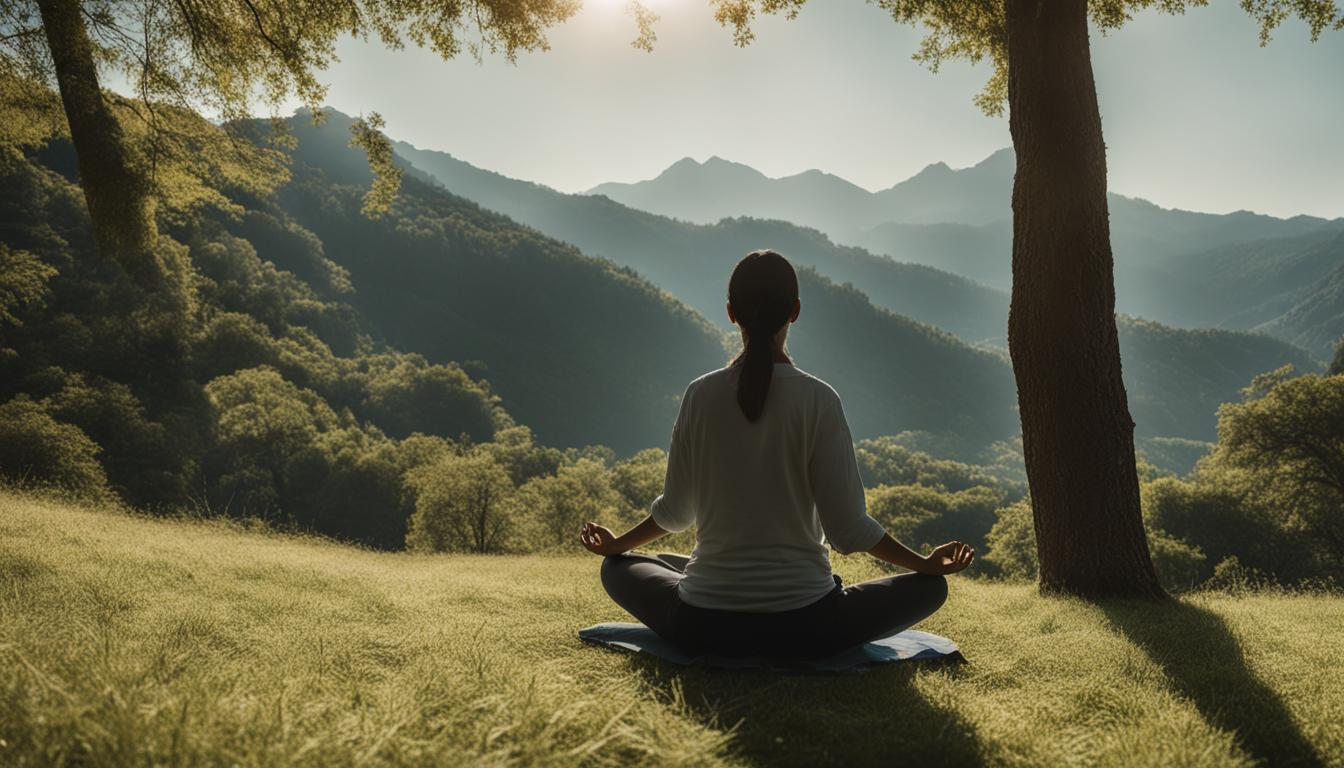Meditation is a practice that allows us to connect with our thoughts, emotions, and body. It doesn’t have to take up a lot of time; even a 2-minute meditation can provide benefits. According to Ponlop Rinpoche, taking just 5 minutes to meditate can help bring mindfulness and awareness into everyday moments. In this article, we’ll explore various short meditation instructions and techniques to help you find calm and relaxation in the midst of a busy schedule.
Key Takeaways:
- Even a 2-minute meditation can provide benefits for busy individuals.
- Taking just 5 minutes to meditate can help bring mindfulness and awareness into everyday moments.
- Short meditation techniques can help you find calm and relaxation in a busy schedule.
- Consistent meditation practice, even for a few minutes a day, can reduce stress and improve clarity and focus.
- Setting aside a small amount of time for yourself each day can enhance your overall well-being.
The Power of Goodwill Meditation
One way to start your day with a sense of goodness and kindness is through goodwill meditation. This practice involves offering thoughts of goodwill to yourself and gradually extending those thoughts outward to others. Thanissaro Bhikkhu suggests starting by sending thoughts of happiness and freedom from stress and pain to yourself. Then, you can extend these thoughts to loved ones, neutral acquaintances, and even those you have difficulties with. This meditation can help cultivate a sense of connection and empathy toward all beings.
Imagine the power of starting each day with love and kindness radiating from within you. Goodwill meditation allows you to tap into that power, spreading positive energy and compassion to yourself and those around you. By focusing on thoughts of happiness, freedom from stress, and well-being, you can cultivate a mindset of mindfulness and gratitude.
Close your eyes, take a deep breath, and visualize yourself surrounded by a warm, loving light. Allow this light to penetrate every cell of your being, filling you with a sense of peace and contentment. As you exhale, imagine that this light expands outward, enveloping your loved ones, colleagues, and even strangers with the same feelings of happiness and freedom from pain.
You have the power to touch the lives of others through the simple act of goodwill meditation. As you extend your thoughts of kindness and compassion, you create a ripple effect of positive energy that can uplift not only yourself but also those who cross your path. By embracing this practice, you can cultivate a sense of connection and empathy toward all beings, fostering a harmonious and compassionate world.

Embracing Affliction Meditation
Ken Jones, a Buddhist activist, introduced a powerful meditation practice that can help you navigate difficulties and pain. This technique revolves around reflecting on your emotional responses to afflictions and asking yourself probing questions. By doing so, you can gain valuable insights into your own suffering and find ways to let go of unhelpful reactions. This practice promotes self-awareness and personal growth while building resilience in the face of adversity.
Meditating on affliction serves as a gentle reminder that acknowledging and embracing our difficulties can lead us to a place of healing and strength. In the words of Ken Jones himself, “By embracing our afflictions, we can release their hold on us and open up the possibility for deep transformation within.” This meditation technique is especially beneficial for those seeking stress relief and looking for guided meditation practices that can provide a new perspective on their daily challenges.

Your Guide to Embracing Affliction Meditation
To practice the Embracing Affliction Meditation, follow these simple steps:
- Find a quiet and comfortable space where you won’t be disturbed.
- Sit in a relaxed position, close your eyes, and take a few deep breaths to center yourself.
- Reflect on a recent difficulty or affliction that you’ve experienced. It could be a challenging situation, an emotional struggle, or even a physical pain.
- Allow yourself to fully feel the emotions associated with this affliction without judgment or resistance.
- Now, begin to ask yourself questions about your emotional responses. What thoughts arise? How do these emotions manifest in your body? How do you typically react to such difficulties?
- Observe the patterns and tendencies that emerge. Are these reactions helpful or harmful? Are they based on past conditioning?
- As you gain clarity, imagine releasing these unhelpful responses. Visualize them dissipating like wisps of smoke, leaving you with a sense of calm and acceptance.
- Take a few more deep breaths to integrate this experience and cultivate a feeling of peace within.
Repeat this meditation practice whenever you face a challenging situation or need to relieve stress. By embracing your afflictions, you can transform your relationship with difficult emotions and cultivate greater emotional resilience.
Calming Monkey Mind Meditation
Do you often find your mind racing with thoughts and distractions, pulling you away from the present moment? This phenomenon is commonly referred to as monkey mind. But don’t worry, there’s a simple meditation technique that can help you find calm and focus.
A practitioner named Davis suggests asking yourself three questions whenever you feel overwhelmed by the restlessness of your mind:
- What am I thinking about?
- How do these thoughts make me feel?
- Is this helping me stay present or taking me away from the present moment?
By consciously pausing, asking yourself these questions, and observing your surroundings, you can bring yourself back to the present moment. This practice helps to tame the restlessness of your mind, allowing you to cultivate a sense of groundedness and mindfulness.

Take a moment to visualize yourself implementing this technique. Close your eyes, take a deep breath, and imagine the soothing effect it has on your mind. By incorporating this meditation into your daily routine, especially during stressful or busy times, you can experience greater peace and clarity.
Cultivating Peace and Connection Meditation
The meditation practice of interconnectedness reminds us of our deep connection with all beings and the world around us. By recognizing and offering thoughts of peace to everyone we encounter, including those who have caused us difficulties, you can cultivate a sense of universal compassion.
This meditation expands your awareness beyond yourself and helps you foster a sense of peace and connection with all of humanity. It allows you to see the interconnectedness of all beings and the impact your thoughts and actions can have on others.
To practice this meditation, find a quiet and comfortable space where you won’t be disturbed. Close your eyes and take a few deep breaths to relax your body and mind.
Visualize yourself surrounded by a radiant light that represents peace and love. With each inhale, imagine this light filling your entire being, bringing a sense of calm and tranquility.
As you exhale, send thoughts of peace and well-being to all the people you encounter in your daily life. This includes family, friends, coworkers, and even strangers. Imagine this peaceful energy flowing from your heart to theirs, nurturing a sense of connection and compassion.
Take a moment to specifically focus on anyone who has caused you difficulties or pain. With an open heart, offer them thoughts of understanding, forgiveness, and peace. Recognize that everyone is on their own journey, and by offering compassion to those who have hurt you, you can release any negative emotions and cultivate a sense of healing and inner peace.
Continue this meditation for as long as you feel comfortable, allowing the feelings of peace and connection to deepen with each breath. When you’re ready, gently bring your awareness back to your surroundings and open your eyes.

The practice of cultivating peace and connection through meditation can have a profound impact on your well-being and relationships. By nurturing a sense of universal compassion, you can create a more harmonious and peaceful world both within yourself and in your interactions with others.
The Power of Pause Meditation
Pause practice is a powerful tool in your meditation journey, allowing your mind to relax and let go of the constant stream of thoughts. According to Pema Chödrön, a renowned Buddhist teacher, this practice involves taking three conscious breaths and then pausing, as if popping a bubble. By consciously pausing, you can step outside your habitual thought patterns and be fully present in the moment.
Imagine the feeling of taking a pause, like pressing the pause button on a movie. As you pause, you become aware of your surroundings, embracing the magic and beauty that often goes unnoticed. Everything seems to slow down, allowing you to immerse yourself in the immediacy of your experiences.
This moment of stillness and peace can be particularly beneficial for beginners who are just starting their meditation journey. It provides a simple and accessible technique to calm the mind and find inner tranquility.
Take a deep breath in through your nose, feeling the air fill your lungs. Exhale slowly through your mouth, releasing tension and stress. Let go of any worries or distractions, allowing your mind to settle into the present moment. Embrace the stillness and peace that arise as you take this pause.

Pause practice offers a moment of respite from the chaos of daily life. It helps you reconnect with yourself and the world around you, promoting relaxation and a sense of calm. – Pema Chödrön
Embracing the Magic of the Pause
During this pause, notice the small details that often go unnoticed—the gentle breeze on your skin, the birds chirping in the distance, or the scent of freshly brewed coffee. Embrace these magical moments, allowing them to anchor you in the present.
The power of the pause lies in its ability to shift your focus from the busyness of the mind to the richness of the present moment. It offers a momentary escape from the constant flow of thoughts, giving you the opportunity to recharge and find clarity.
The Benefits of Pause Practice
Integrating pause practice into your daily meditation routine can bring numerous benefits. It helps cultivate a sense of relaxation, reducing stress and anxiety. By taking regular pauses throughout the day, you can refresh your mind and increase your overall productivity.
Additionally, pause practice enhances your ability to be fully present in your relationships and interactions. It promotes mindfulness, allowing you to listen deeply and engage with others in a more meaningful way.
Next time you find yourself caught up in the rush of daily life, remember the power of the pause. Take a few conscious breaths, pop the bubble of busyness, and embrace the magic of the present moment. Allow yourself to experience the stillness and peace that arise as you take this pause.
Loving-Kindness Toward Ourselves Meditation
Self-compassion plays a vital role in our journey of meditation and personal growth. During this practice, Susan Piver suggests using visualization to offer loving-kindness to different aspects of ourselves. We can envision ourselves as beloved, wise, a stranger, or even as an enemy, embracing and extending kindness to all parts of our being. This meditation is a powerful tool for cultivating self-acceptance, self-love, and a deep sense of interconnectedness with all aspects of ourselves.

Take a moment to close your eyes and imagine yourself enveloped in love and kindness. Picture yourself radiating a warm, comforting energy, embracing your flaws, strengths, and all that makes you unique.
Conclusion
Incorporating a quick 2-minute meditation into your daily routine can have numerous benefits for your mental and physical well-being. Research shows that consistent meditation practice, even if it’s just a few minutes a day, can reduce stress and improve overall clarity and focus. By setting aside a small amount of time for yourself each day, you can experience the positive effects of meditation and find greater calm amidst the busyness of life.
Start with these short meditation techniques and see how they can enhance your overall well-being. Whether you’re a beginner or have been practicing meditation for a while, these quick and easy methods can help you cultivate inner peace and mindfulness in your everyday life.
Remember, meditation is a personal journey, so feel free to experiment with different techniques and find what works best for you. The key is to make meditation a regular part of your routine and give yourself the gift of self-care and relaxation.
FAQ
What is the benefit of a 2-minute meditation?
Even a 2-minute meditation can provide benefits such as reducing stress and improving focus and clarity.
How can goodwill meditation benefit me?
Goodwill meditation helps cultivate a sense of connection and empathy toward all beings.
What is the purpose of embracing affliction meditation?
Embracing affliction meditation encourages us to gain insight into our suffering and let go of unhelpful responses.
How can I calm my monkey mind?
Calming monkey mind meditation involves re-establishing presence by asking three questions and grounding yourself in the present moment.
How can cultivating peace and connection meditation help me?
Cultivating peace and connection meditation expands our awareness beyond ourselves and fosters a sense of compassion and peace.
How can pause meditation help me relax?
Pause meditation allows our minds to relax by stepping outside our habitual thought patterns and being fully present in the moment.
How does loving-kindness meditation benefit us?
Loving-kindness meditation helps cultivate self-acceptance, self-love, and a sense of interconnectedness with all aspects of ourselves.
Source Links
- https://www.lionsroar.com/two-minute-meditations/
- https://www.notsalmon.com/2014/08/06/too-busy-to-meditate/
- https://www.headspace.com/meditation/short-meditation


